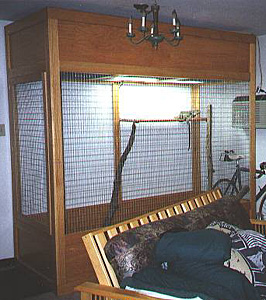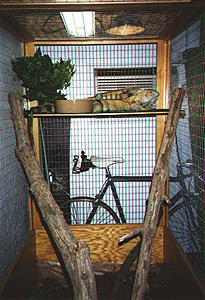Wood Framed Large Indoor Cage
 This was really quite a production for us. We were in school at the time we built
it, and it took a year to complete. This cage measures 8' x 8' x 3.5' and is made
out of red oak. It's really a great design, if I do say so myself, because it
comes apart into 15 pieces and flat-packs into a 3.5' x 8' pile of wood less than
a foot high. It all fits into a Plymouth Voyager. There are five long vertical
pieces which bolt into threaded inserts in the remaining pieces;
these five long pieces hold the entire cage together. The remaining pieces are
the flat panels - two on each side - one on the top part and one on the bottom, and
then the top and the bottom of the cage are 8' x 3.5' pieces of plywood.
Get it?
This was really quite a production for us. We were in school at the time we built
it, and it took a year to complete. This cage measures 8' x 8' x 3.5' and is made
out of red oak. It's really a great design, if I do say so myself, because it
comes apart into 15 pieces and flat-packs into a 3.5' x 8' pile of wood less than
a foot high. It all fits into a Plymouth Voyager. There are five long vertical
pieces which bolt into threaded inserts in the remaining pieces;
these five long pieces hold the entire cage together. The remaining pieces are
the flat panels - two on each side - one on the top part and one on the bottom, and
then the top and the bottom of the cage are 8' x 3.5' pieces of plywood.
Get it?As with all of my cages, galavanized steel wire from Da-Mar's (call 1-800-952-8669 for a catalog) was used to flesh out the cage. The cage wire slides into grooves we cut into the wood using a router. The door is a solid structure which does not come apart. The wood on this cage was sealed with 2-3 coats of polyurethane. Note that when the top photograph was taken the basking shelves were not yet complete! This cage, as is, does not provide nearly enough stimulation for any iguana.
In the second photo you can see one of the three sections of wire on which the lights sit. These solid panels sit atop a ledge which was created for them, and can be moved around freely and removed. This makes it easy to change lightbulbs and lighting setups. Ideally, the lights would hang from the top of the cage rather than simply sit atop these panels, but that just hasn't happened yet.
This cage took some considerable planning, and the plans were even changed halfway through construction. This cage contains a lot of wood, and while the least expensive hardwood was used (red oak) the wood alone cost several hundred dollars. To create this cage we employed the use of a table saw, miter saw, router, drill, power sanders, and of course wire cutters. We wanted to create a cage that would look like a piece of furniture, and I think we succeeded. This cage currently houses one five-foot, 13 pound iguana and one three-foot iguana (Sherbert and Squashie!). There are now three shelves and two ramps attached to the cage sides. There is plenty of room for both iguanas to bask, eat, poop, and sleep, but they are let out of their cage every day for further stimulation. The only cage suitable for keeping an iguana in at all times would have to be the size of a room - either one of the rooms in your home or an enormous cage constructed outdoors or in an unused part of your home.
